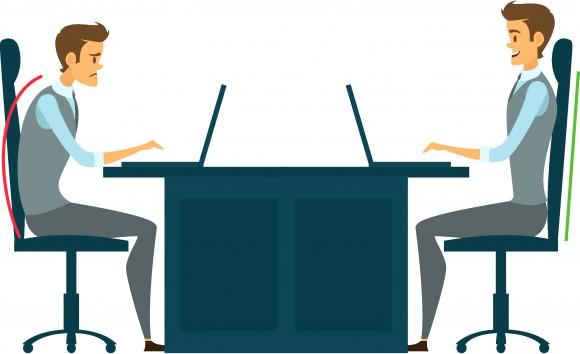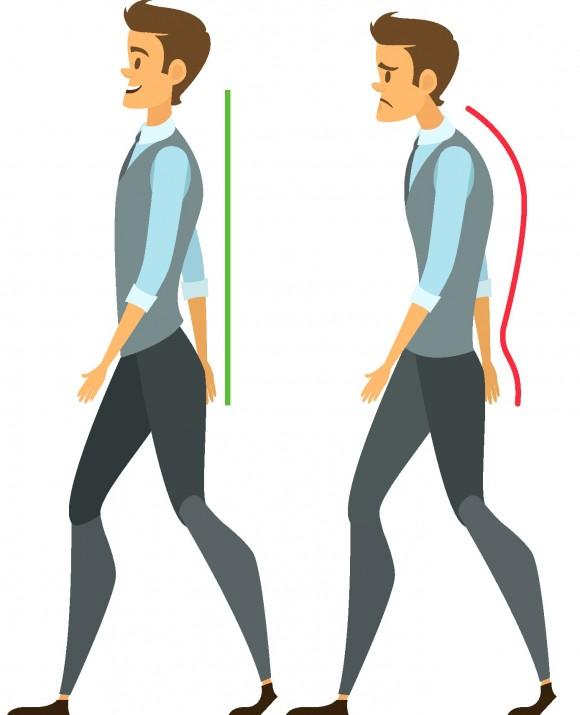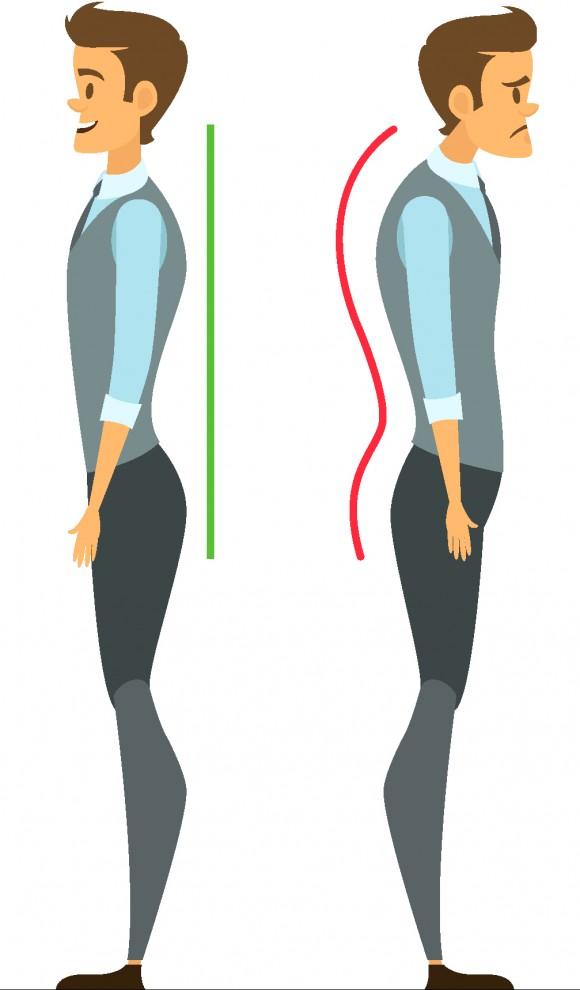Today we enjoy comforts unknown to our ancestors, yet the modern world can still be hard on the body. We now spend more time sitting—and slouching—than ever before, and researchers say this luxury comes at a price.
“We live in a sitting-centric society and the health risk is huge,” said Dr. Steven Weiniger, a posture expert, appointed delegate to the White House Conference on Aging and author of “Stand Taller Live Longer: An Anti-Aging Strategy.”
Sitting feeds into slouching and being sedentary with poor posture can erode the body’s architecture, says Weiniger. The human body functions best when the major structural elements–head, torso, and pelvis–are in alignment, with one neatly stacked on top of the other.
Macrovector/Shutterstock Illustrations
When we spend so much of our lives in a seated position, we begin to take on a hunched over shape.
When we spend so much of our lives in a seated position, we begin to take on a hunched-over shape. Over time, the muscles that are supposed to hold us upright become weak and lose the ability to provide support as they were designed to. All those hours we spend in a car, behind a desk, or in front of the television gradually take a toll.
The Epoch Times talked to Weiniger about the impact posture has on our health, how our lifestyle can affect our body’s structure, and how we can correct poor posture.
The Epoch Times: Why is posture important?
Dr. Steven Weiniger: The physical structure of our body is just as important as the chemical structure of our body, but we don’t appreciate that subtle asymmetries can compound into greater issues over time.

Macrovector/Shutterstock Illustrations
It’s mechanical. If you take the body and fold it—with your head forward of your torso, and your torso forward of your pelvis (a common position for sitting or texting)—you can’t breathe as well. There is more pressure on your visceral organs, and they aren’t functioning as well as they should.
You can see this immediately by performing a quick exercise. In the position you’re in right now, take a deep breath and notice how much air you’re getting. Now, try to sit up or stand up taller. Lift your head tall, shrug your shoulders up, make your chest broad, then pull your shoulders back and down. Now take a deep breath.
You will notice you are able to take in more air because your chest cavity could expand more. Breathing is good for your health. Not only does it help you take in oxygen, but your lungs also help your body pump out toxins. They are your largest excretory organs.
The muscles you used when you took that deep breath are muscles you are not using when your body is hunched forward. Over time, you‘ll find you’ll return to the slouched position and go back to not breathing well.
You can really feel this when you’re exercising. If your posture is folded, you’re not going to be getting in enough air, and you’re not going to exercise as effectively to make those muscles work, and that includes your heart. It can have a negative effect on cardiovascular health.
The Epoch Times: What other things affect our posture?
Dr. Weiniger: Everything you do affects your posture. If you’re sleeping in a bed that is not supporting you with symmetry, it’s the same thing as sitting in a chair that tilts to one side all day long at work. If you sleep on your stomach with your head turned to the right, your posture is subtlety going to shift in that direction. It’s not dramatic, but it will be over time.
There's an epidemic I'm seeing now that's not being recognized: Kids are becoming more hunched over than their parents.

Kids are becoming more hunched over than their parents. Yeko Photo Studio/Shutterstock
There’s an epidemic I’m seeing now that’s not being recognized: Kids are becoming more hunched over than their parents. The reason is that these kids are spending more time than any previous generation hunched over their cellphones and devices.
Part of the problem is that when they’re texting they’re looking down, but what makes it worse is what they do with their hands. In order to type accurately, you can’t be wobbling around, so to keep this from happening you lock everything higher up the chain—your wrists, elbows, spine, and torso. You’re training your body to be locked into this position for big chunks of the day.
The Epoch Times: Now that you’re talking about it, I’m sitting up straighter. But I’m sure that later today I'll return to my familiar slouch. What can we do to get this to stick?
Dr. Weiniger: Awareness is the first step. We suggest people get a baseline awareness of what their posture actually looks like. We take a picture of a patient standing up straight and tall against a grid background so we can precisely measure the position of their head, torso, and pelvis and see the deviation. Then we track it by taking the same picture every year. Over time things can get better or worse depending upon what you do. If you start doing something different—taking control of your life and your body—then your posture improves. So the second thing we teach is control.
For control, we teach our own postural exercises, but there are many different types of postural exercises—things like yoga, Pilates, and Tai Chi. These are exercises that use intentional focus. They are not the same as gym exercises, which don’t always focus with precision on different parts of your body.
Postural exercises strengthen balance, alignment, and motion so that people become more aware of their posture.
, postural specialist

Macrovector/Shutterstock Illustrations
Postural exercises strengthen balance, alignment, and motion so that people become more aware of their posture. It’s not five minutes today and you’re done. It’s about developing a habit. We suggest people do these exercises on a daily basis.
The third thing we teach is building an intelligent posture environment. It’s about tailoring your physical environment to your body. If you’re sitting, have a good chair. Or even better, have a desk that goes up and down so that you’re not sitting all the time.
The Epoch Times: Tell me about the exercises you recommend for good posture.
Dr. Weiniger: When we teach strong postural exercises, we call it BAM 321.
- Three times a day, check in with your balance with real intention and focus on your posture. To demonstrate your strength of balance, stand up straight, and lift your left leg so that your thigh is parallel to the ground. Keep on standing tall and hold that for about 15 seconds, then slowly put it down. Do the same thing on the right side. As you hold this position, be aware of what standing tall feels like. You probably have to shift things to keep your balance. Most people feel that both sides don’t feel quite the same. One side usually has better balance. Depending upon how asymmetric your posture is, you’re going to see a greater perception of what you need to do to balance.
- Two times a day, check your alignment. Press the back of your pelvis, torso, and head against a wall so they’re all on one level. Many people can’t put the back of their head against a wall without putting their chin up. You want to push the back of your head against the wall without looking up, but if there’s tightness in your neck at a point when you try to do this, that’s the limit. Don’t push past that. It’s something you have to progress toward.
- Once a day, check your motion. Sit on an exercise ball to move your body in three dimensions using your core and find weak links in the chain by observing how smoothly you’re moving. The goal is moving with control.
The Epoch Times: What is the function of the exercise ball in your posture exercises? And what do you think of the trend of using a ball as an office chair?
Dr. Weiniger: The cool thing about a ball is that it moves in three dimensions. The whole idea is getting it to roll.
When you’re sitting on a ball with symmetry, you can balance. If you sit on it with asymmetry, you’re going to fall off, and your body will react to keep your balance and stabilize. It forces you to use muscles subtly and gets your body to perceive where its imbalance is and correct it.
The problem with these balls is sometimes they’re too small. When you’re sitting on a ball you want your hips to be above your knees. If your hips are below your knees, then the hip flexor muscles are going to be in a shortened position. People are already folded when they’re sitting, but you don’t want to fold it past 90 degrees. People also often incorrectly sit directly on top of the ball, but you should be seated on the front third of it.
The problem with a ball, as with a chair, is getting your knees to fit under the desk. If you can get a desk that’s high enough, a ball is great.
Answers have been edited for clarity and brevity.






